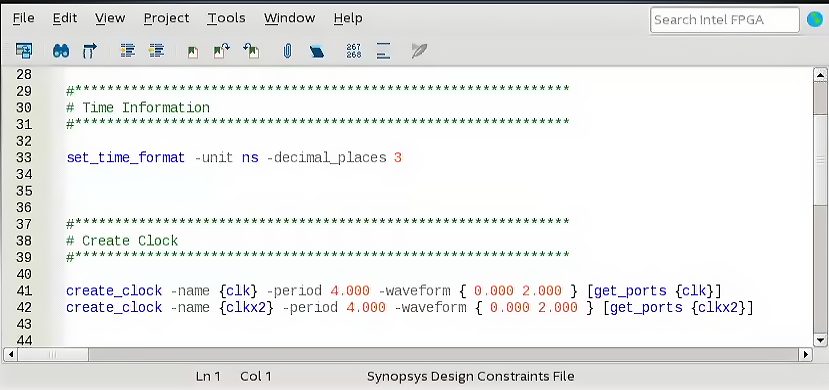A newer version of this document is available. Customers should click here to go to the newest version.
3.3.1. Project Creation
3.3.2. Design Entry
3.3.3. IP Status
3.3.4. Design Constraints
3.3.5. Synthesis
3.3.6. Design Implementation
3.3.7. Finalize Pinout
3.3.8. Viewing and Editing Design Placement
3.3.9. Static Timing Analysis
3.3.10. Generation of Device Programming Files
3.3.11. Power Analysis
3.3.12. Simulation
3.3.13. Hardware Verification
3.3.14. View Netlist
3.3.15. Design Optimization
3.3.16. Techniques to Improve Productivity
3.3.17. Cross-Probing in the Intel® Quartus® Prime Pro Edition Software
4.2.1.2.1. Memory Mode
4.2.1.2.2. Clocking Mode
4.2.1.2.3. Write and Read Operation Triggering
4.2.1.2.4. Read-During-Write Operation at the Same Address
4.2.1.2.5. Error Correction Code (ECC)
4.2.1.2.6. Byte Enable
4.2.1.2.7. Address Clock Enable
4.2.1.2.8. Parity Bit Support
4.2.1.2.9. Memory Initialization
4.2.1.2.10. Output Synchronous Set/Reset
3.3.4.3. Create Timing Constraints with the Timing Analyzer Text Editor
The Intel® Quartus® Prime Timing Analyzer (Tools > Timing Analyzer ) reads and writes timing constrains in the industry-standard Synopsys* Design Constraint (SDC) format. The Timing Analyzer provides a GUI interface that allows you to manually create and modify timing constraints.
Note: Ensure that the project is open before using the Timing Analyzer.
- To create a new SDC file from the Timing Analyzer, click File > New SDC File.
- To apply templates for SDC constraints, click Edit > Insert Template command.
The Timing Analyzer Text Editor uses syntax coloring for SDC reserved words and comments.
Figure 6. Timing Analyzer Text Editor